Risk of relapse increases if medication halted too soon

By Jason Springer, MD, and Alexandra Villa-Forte, MD, MPH
Cleveland Clinic is a non-profit academic medical center. Advertising on our site helps support our mission. We do not endorse non-Cleveland Clinic products or services. Policy
Duration of Maintenance Therapy for GPA (Wegener’s): Longer Appears to Be Better
A major goal of the management of patients with granulomatosis with polyangiitis (GPA) (Wegener’s) is the prevention of relapses, which have the potential to threaten organ function and even lead to death. This has resulted in the practice of using immunosuppressive medications for the maintenance of GPA remission following induction therapy.
Patients frequently ask about the duration of maintenance therapy because of concerns about these medications’ potential long-term side effects. However, there is limited published evidence on how long maintenance therapy should continue. We recently conducted a retrospective study to assess patient outcomes according to the length of maintenance therapy to sustain GPA remission. We share our results here and discuss their implications for the duration and dosing of maintenance therapy for GPA.
The prognosis for GPA has changed dramatically over the past 50 years. With current induction strategies using cyclophosphamide (CYC), rituximab (RTX) or methotrexate (MTX), more than 90 percent of patients are able to achieve remission. Once remission is achieved, typically after three to six months of therapy, patients are transitioned to maintenance medications.
Both MTX and azathioprine (AZA) have been shown to be effective maintenance agents in prospective studies. With these current treatment strategies, mortality and morbidity have improved and GPA has increasingly become a chronic disease. Yet because these medications can be associated with adverse effects, particularly infections, these effects must be weighed against the medications’ potential benefits.
Figure. Kaplan-Meier curves for relapse-free remission in 157 GPA patients according to duration of maintenance therapy.
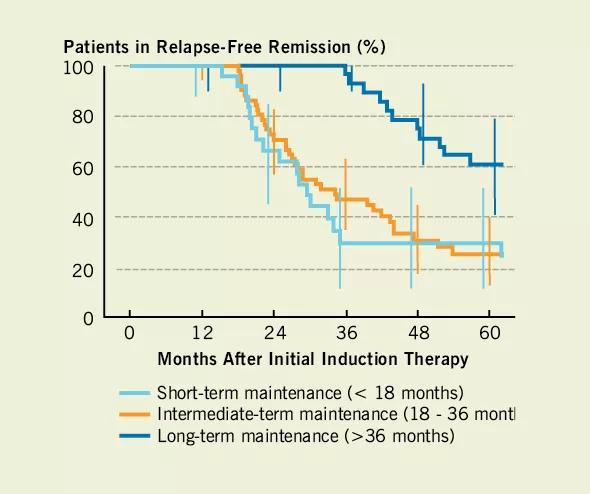
Figure. Kaplan-Meier curves for relapse-free remission in 157 GPA patients according to duration of maintenance therapy.
Patients often ask how long they will need to continue taking the maintenance medications. Prospective studies have supported the use of maintenance medications for up to 18 months for prevention of GPA relapse. Data to support continuing maintenance medications beyond 18 months are limited. Continuation of therapy beyond this time depends on clinical judgment. Patients who have experienced multiple relapses are usually on continuous treatment for maintenance of remission.
Little is known, however, about the ideal duration of therapy for patients who demonstrate sustained remission and have no history of relapses. Our study focused on this subset of patients.
We retrospectively analyzed 157 patients treated at Cleveland Clinic for newly diagnosed GPA who were able to sustain remission for at least 18 months. Mean follow-up was 3.1 years (range, 18.5 months to 16.8 years). Induction therapy with CYC was used for severe disease (78 percent of cases) and MTX for mild to moderate disease (22 percent of cases).
Continuation of either MTX or AZA for maintenance therapy for longer than 18 months resulted in a nonsignificant 29 percent reduction in the hazard ratio (HR) for GPA relapse (HR = 0.71 [95% CI, 0.42-1.19], P = .19) compared with continuation for 18 months or less. In contrast, continuation of maintenance therapy for longer than 36 months resulted in a 66 percent reduction in the risk for relapse (HR = 0.34 [95% CI, 0.15-0.76], P = .008) compared with continuation for 36 months or less (Figure). When duration of treatment was considered as a continuous variable, longer courses showed an inverse relationship with the risk of relapse (HR = 0.70 [95% CI, 0.58-0.84], P < .001), which remained significant even after adjustment for prednisone dose (HR = 0.59 [95% CI, 0.42-0.83], P = .003).
Among patients who continued AZA or MTX for longer than 18 months, 90 percent of the relapses occurred after they stopped maintenance therapy. This is consistent with a prior study demonstrating a high relapse rate after discontinuation of maintenance therapy.1 Of patients taking MTX or AZA at relapse, 52 percent were taking less than 15 mg/week of MTX, and 67 percent were taking less than or equal to 50 mg/day of AZA. There were no differences between the groups in overall adverse events or GPA-related morbidity.
Physicians and patients frequently discuss the possibility of stopping maintenance medications following long periods of sustained remission, especially if patients have never had a relapse. However, GPA characteristically has a relapsing course, and results from our study support continuation of maintenance medications for at least 36 months. When possible, clinicians should strive to use maintenance medications at doses used in clinical trials (at least 15 mg/week for MTX and approximately 2 mg/kg for AZA). Lower doses are associated with a higher risk of relapse, as demonstrated by our data.
1. Villa-Forte A, Clark TM, Gomes M, et al. Substitution of methotrexate for cyclophosphamide in Wegener granulomatosis: a 12-year single-practice experience. Medicine (Baltimore).2007;86(5):269-277.
Dr. Springer is a former vasculitis fellow in the Department of Rheumatic and Immunologic Diseases.
Dr. Villa-Forte is a staff physician in the Center for Vasculitis Care and Research within the Department of Rheumatic and Immunologic Diseases. She can be contacted at 216.445.9437 or villaa@ccf.org.

Older Psoriasis Patients May Experience Quicker Transition

Cleveland Clinic’s Rheumatic Lung Disease program treats patients with complex conditions
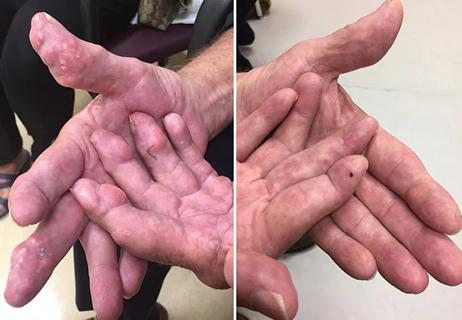
Some patients exhibit marked nodulosis due to undiagnosed tophi
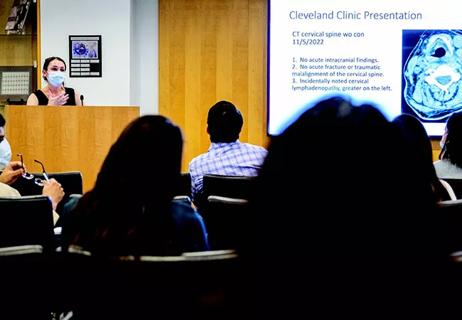
A century-old medical tradition inspired the weekly complex-case reviews in Rheumatology

Multidisciplinary care may help clear barriers to treatment
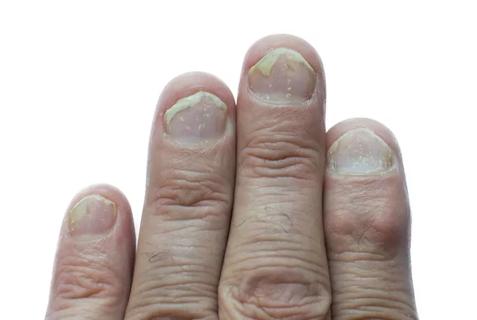
Genetic polymorphisms and response to TNFα blockers
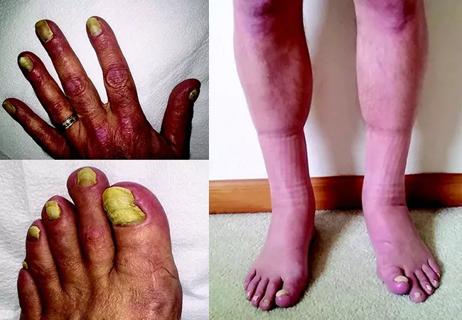
Patient’s 2-year symptom history leads to an uncommon diagnosis

Adam Brown, MD, shares his passion for solving rheumatologic mysteries